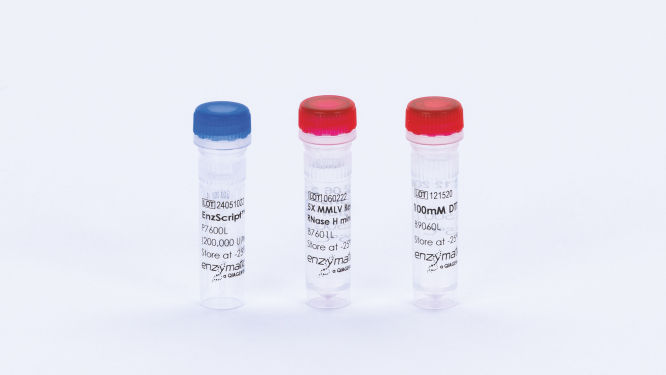Cat. No. / ID: P7600L
Features
- RNase H-deficient M-MLV with increased thermal stability
- Suitable for cDNA cloning and RT-PCR
- Recommended for library construction for RNA-Seq transcriptome studies
- Compatible with random hexamer, oligo(dT) and gene-specific priming
Product Details
EnzScript Reverse Transcriptase is a Moloney Murine Leukemia Virus (M-MLV) reverse transcriptase with point mutations in the RNase H domain that eliminate detectable RNase H activity. EnzScript can be used to generate first-strand cDNA from poly(A) mRNA or total RNA for use in downstream applications such as RT-PCR, cDNA cloning or library construction for RNA-Seq. The point mutations in the RNase H domain increase the thermostability of the enzyme and support greater cDNA yield of full-length transcripts than wild type M-MLV reverse transcriptase.
One unit of EnzScript Reverse Transcriptase is defined as the amount of enzyme required to incorporate 1 nmol of dTTP into acid insoluble material in 10 minutes at 37°C using poly r(A)/oligo(dT) as a substrate.
EnzScript Reverse Transcriptase is supplied in 20 mM Tris-HCl, 100 mM NaCl, 0.1 mM EDTA, 1 mM DTT, <0.01% NP-40 stabilizer and 50% glycerol; pH 7.5 at 25°C.
EnzScript Reverse Transcriptase is supplied with 5X M-MLV Reverse Transcriptase RNase H– Reaction Buffer (cat. no. B7601) and 100mM DTT (cat. no. B9060).
Performance
Polymerase properties
- Optimum extension temperature: 42°C
- Transcript length: Up to 9.4 kb
| Test | Specification |
| Purity | >95% |
| Specific activity | 180,000 U/mg |
| Single-stranded exonuclease | 2000 U <5% released |
| Double-stranded exonuclease | 2000 U <1% released |
| Double-stranded endonuclease | 2000 U = No conversion |
| E. coli DNA contamination | 2000 U <10 copies |
| RNase contamination | 2000 U; No detectable non-specific RNase |
| Functional RT-PCR assay | Synthesis of 9.4 kb cDNA transcript |
Principle
Reverse transcriptase (RT), also known as RNA-dependent DNA polymerase, is a DNA polymerase enzyme that transcribes single-stranded RNA into DNA. Reverse transcriptases are used by viruses such as HIV and hepatitis B to replicate their genomes.
Reverse transcriptases are used in molecular biology to detect and manipulate RNA molecules through amplification. Reverse transcriptases polymerize a strand of DNA (cDNA) that is complimentary to an original RNA template. The cDNA can then be further amplified through PCR, and qPCR for downstream analysis of transcripts and gene expression.
Native retroviral RT has three sequential biochemical activities: RNA-dependent DNA polymerase activity, ribonuclease H (RNase H) activity and DNA-dependent DNA polymerase activity. Collectively, these activities enable the enzyme to convert single-stranded RNA into double-stranded cDNA.
RNase H activity degrades the RNA strand of a DNA/RNA hybrid and frees the newly made DNA strand for use as a template in the synthesis of the second strand of DNA. RNase H activity is considered disadvantageous for synthesis of long cDNAs due to the potential of the enzyme to degrade the RNA template before completion of full-length reverse transcription.
EnzScript Reverse Transcriptase has no detectable RNase H activity and has increased thermostability. The enzyme is suitable for generating first-strand cDNA from poly(A) mRNA or total RNA for use in downstream applications such as RT-PCR, cDNA cloning or library construction for RNA-Seq.
Procedure
Instructions for using EnzScript Reverse Transcriptase are provided in the corresponding kit protocol in the resources below.
Quality Control
Unit activity of EnzScript Reverse Transcriptase was measured using a two-fold serial dilution method. Dilutions of enzyme were made in 1X M-MuLV RT RNAse H- Buffer and added to 50 μL reactions containing 20 μg/mL poly r(A) RNA, oligo (dT) DNA, 1X RT Buffer, 3H-dTTP and 250 μM dTTP. Reactions were incubated 10 minutes at 37°C, plunged on ice, and and analyzed using the method of Sambrook and Russell (Molecular Cloning, v3, 2001, pp. A8.25-A8.26).
Protein concentration of EnzScript Reverse Transcriptase (OD280) was determined by OD280 absorbance.
EnzScript Reverse Transcriptase physical purity was evaluated by SDS-PAGE of concentrated and diluted enzyme solutions followed by silver stain detection. Purity was assessed by comparing the aggregate mass of contaminant bands in the concentrated sample to the mass of the protein of interest band in the diluted sample.
Single-stranded exonuclease activity in EnzScript Reverse Transcriptase was determined in a 50 μL reaction containing a radiolabeled single-stranded DNA substrate and 10 μL of enzyme solution incubated for 4 hours at 37°C.
Double-stranded exonuclease activity in EnzScript Reverse Transcriptase was determined in a 50 μL reaction containing a radiolabeled double-stranded DNA substrate and 10 μL of enzyme solution incubated for 4 hours at 37°C.
Double-stranded endonuclease activity in EnzScript Reverse Transcriptase enzyme was determined in a 50 μL reaction containing 0.5 μg of plasmid DNA and 10 μL of enzyme solution incubated for 4 hours at 37°C.
E. coli contamination of EnzScript Reverse Transcriptase was evaluated using 5 μL replicate samples of enzyme solution denatured and screened in a TaqMan qPCR assay for the presence of contaminating E. coli genomic DNA using oligonucleotide primers corresponding to the 16S rRNA locus.
Non-specific RNase contamination of EnzScript Reverse Transcriptase was assessed using a nuclease detection kit following the manufacturer’s guidelines.
Reverse transcriptase function of EnzScript was determined by the enzyme’s ability to generate a 9.4 kB cDNA transcript. Following 2-Step RT-PCR, the 9.4 Kb amplicon was visualized by agarose gel electrophoresis.
Applications
This product is available for molecular biology applications such as:
- RT-PCR amplification
- cDNA cloning
- Library construction for RNA-Seq

